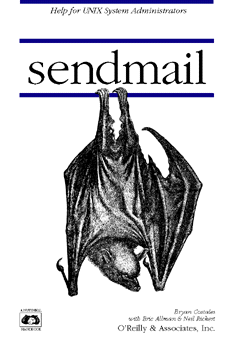
Flying Fox
The animal featured on the cover of Sendmail is the flying fox, a species of fruit bat found chiefly on the islands of the Malay-Indonesia archipelago. Of about four thousand species of mammals, nearly one-quarter are bats; and of these, 160 are fruit bats. Sixty of the larger fruit bats make up the flying foxes, the largest having a wingspan of five feet. As opposed to the smaller insect-eating bats, who navigate by echolocation, fruit bats depend on a keen sense of sight and smell to perceive their environment.Flying foxes roost in trees by day, sometimes in extremely large numbers called "camps." They hang from branches by one or both feet, wrap themselves in their wings, and sleep the day away. On very hot days, these bats keep cool by fanning themselves with their wings.
Greatly elongated fingers form the main support for the web of skin that has allowed these mammals, alone, to master true flight. At sunset they awaken from their slumber and begin their nocturnal ramblings. A flying fox must flap its wings until it becomes horizontal to the ground before it can let go and fly away. Once airborne, they use their sensitive sense of smell to detect where flowers are blooming or fruits have ripened. Unlike most animals, fruit bats cannot generate vitamin C (a limitation shared by humans and guinea pigs); thus, it is supplied by fruit in the diet. Flying foxes can range up to forty miles for food. Once a target is located, they are faced with a difficult landing. Sometimes they will simply crash into foliage and grab at what they can; other times they may attempt to catch a branch with their hindfeet as they fly over it and then swing upside-down; some will even attempt a difficult half-roll under a branch in order to grip it in the preferred position. Once attached and hanging, they will draw the flower or fruit to their mouths with a single hindfoot, or the clawed thumbs at the top of each wing. These awkward landings often cause fights among flying foxes, especially upon their return to camp at dawn. A single bad landing can cause an entire bat-laden tree to become highly agitated, full of fighting and screaming residents.
People have eaten flying foxes for ages. Samoans, who call the flying fox manu lagi, animal of the heavens, use branches bound to the end of long poles to swat the winged delicacy from the sky. Aborigines in Australia build fires beneath flying fox camps -- the smoke stupefies the prey -- and use boomerangs to knock the creatures to the ground.
researched and written by Michael Kalantarian
* One of the more pleasant experiences in life is discovering that someone appreciates your work. I received these two notes in email, soon after this book was published, and both made me feel good for days...
Subject: Pteropids I just had the pleasure of reading the colophon of your "sendmail" book. I'm a biologist who has been working with bats for a number of years now, and I always cringe when someone sends me a clipping from a newspaper, magazine or book on bats, as the facts invariably get entangled with fiction and emerge as a mishmash of misinformation. As a result, it was a delightful surprise to read your colophon. I found your account of flying foxes accurate, detailed, and timely. I don't know where you got your information, but you presented it with admirable clarity and accuracy. Have you ever considered a career in biology? ;) Good luck with your future literary efforts. Regards, April Allgaier Boston University
. . . . . . .
Subject: sendmail colophon Hi, Michael. I really enjoyed the sendmail colophon. Thanks. Carl Steadman